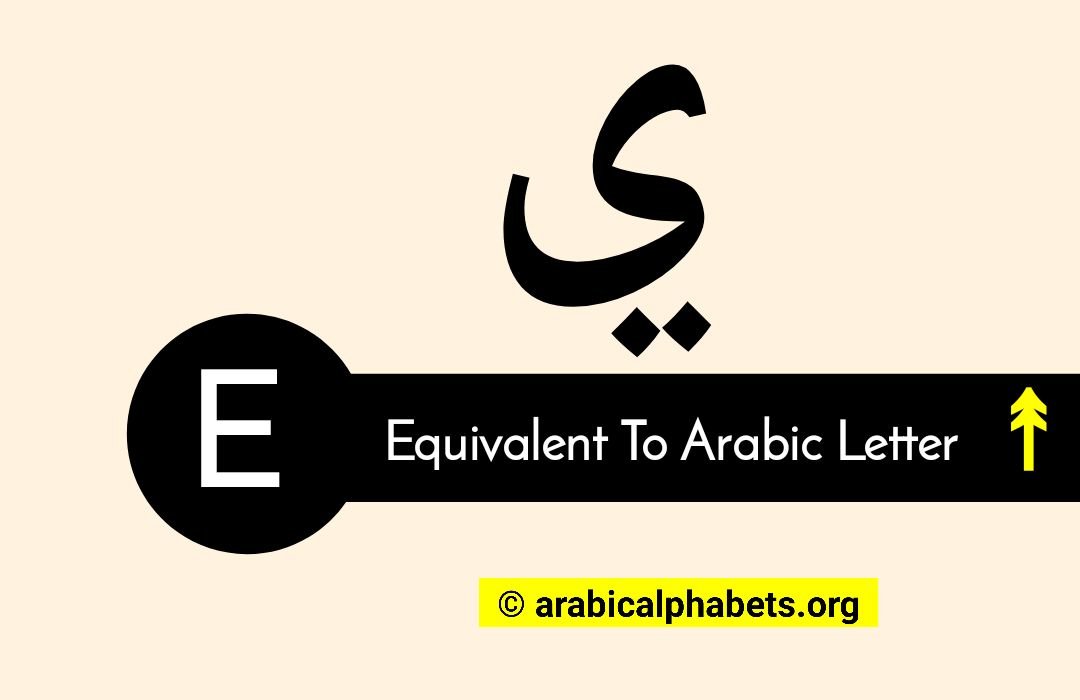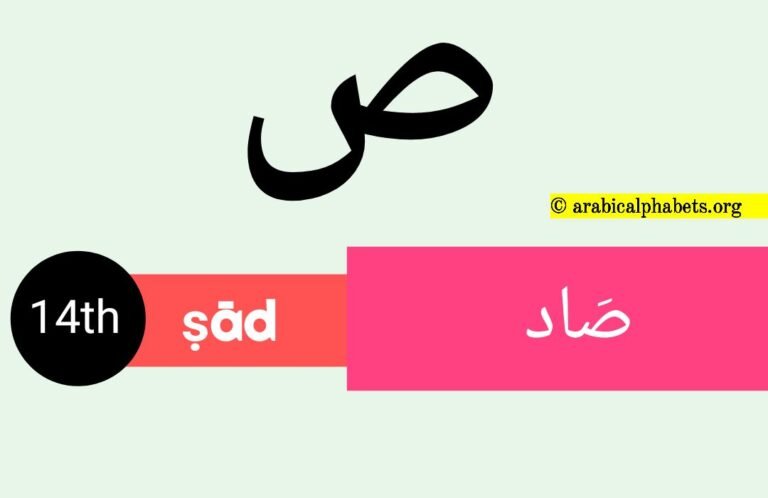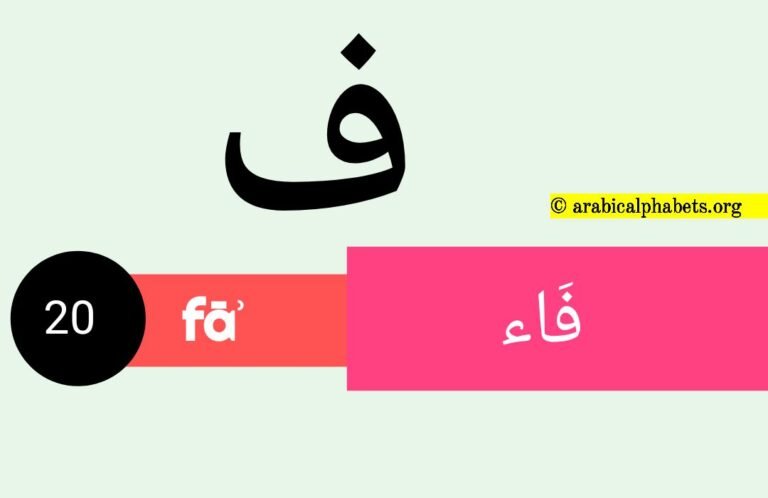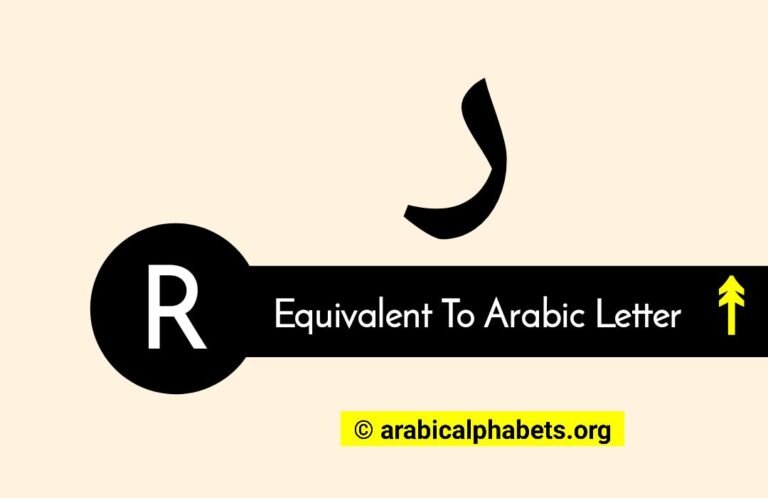The Letter E In Arabic With HD Picture
Are you searching for E in arabic letters on the internet? You can very easily learn Arabic alphabet on this website.
If you want to learn Arabic language alphabet then this is the best website for you. As far as I am aware, you are searching for a in arabic letter on the internet.
What is the E alphabet of English called in Arabic? The letter D in the English language is equivalent to which letter in Arabic? If you are looking for answers to these questions then you can move on.
E In Arabic Letter With Examples
E↠ ي
The Arabic letter “E” is represented by the letter “ي” (Yāʾ) in the Arabic alphabet. This letter corresponds to the sound “ee” as in “tree” in English.
It is commonly used in various Arabic words and has an essential role in forming words and conveying meaning. Here’s a detailed look at the Arabic letter “ي” (Yāʾ) along with examples:
- Arabic Letter: ي
- Pronunciation: “Yāʾ”
- Sound: “ee” as in “tree”
Position: This letter can appear in the initial, medial, or final position within a word, as well as in standalone form.
Examples:
- يَد (Yad) – Hand
- سَيَّارَة (Sayyārah) – Car
- بَيْت (Bayt) – House
- يَقِظَة (Yaqiẓah) – Alertness
- جَمِيل (Jamīl) – Beautiful
- فَيَضَان (Fayāḍān) – Flood
- سَيْف (Sayf) – Sword
- يَسْتَمِعُ (Yastamiʿu) – Listens
- عَيْن (ʿAyn) – Eye
- كَيْفِيَّة (Kayfiyyah) – Manner
In these examples, the letter “ي” (Yāʾ) plays a vital role in shaping the pronunciation and meaning of the words.
It’s important to note that the Arabic language has vowel markings (diacritics) that provide additional details about the pronunciation of vowels.
These diacritics can alter the way the letter “ي” is pronounced depending on its placement within the word.
The Arabic letter “ي” (Yāʾ) is integral to the language and can be found in a wide range of words, contributing to the richness and complexity of Arabic vocabulary.
Remember the pronunciation of the letters in each language are different. But there are many similarities in the letter of Arabic language from the letter of English language.
Yes, remember, equality is not hundred percent. If you read this, then you will find it very easy to learn Arabic language.
Know A To Z Letters Of Arabic Alphabet In English
| Equivalent Letters |
| English | Arabic |
|---|---|
| A | ا |
| B | ب |
| C | ك |
| D | د |
| E | ي |
| F | ف |
| G | ج |
| H | ه |
| I | ي |
| J | ج |
| K | ك |
| L | ل |
| M | م |
| N | ن |
| O | و |
| P | * |
| Q | ق |
| R | ر |
| S | س |
| T | ت |
| U | ي |
| V | * |
| W | و |
| X | * |
| Y | ي |
| Z | ز |
Learn Arabic: A Step-by-Step Beginner’s Guide for Language Enthusiasts
Embark on your Arabic language journey! Whether you’re exploring its rich culture, planning a visit to an Arabic-speaking region, or simply love learning new languages, this beginner’s guide is your perfect starting point to mastering Arabic.
1. Why Learn Arabic? Arabic ranks the world’s fifth most widely spoken language, boasting over 300 million native speakers spanning diverse regions.
It opens doors to engaging with diverse cultures, improving career prospects, and deepening your understanding of history and literature.
2. Setting Clear Goals: Define your reasons for learning Arabic. Do you want to focus on Modern Standard Arabic (MSA) for formal communication or a specific dialect for day-to-day interactions? Setting clear goals will guide your learning journey.
3. The Arabic Alphabet and Pronunciation: Start with the Arabic script – a beautiful and intricate writing system. Learn the 28 letters and their various forms, along with the unique phonetic sounds of Arabic that may differ from those in your native language.
4. Basic Arabic Phrases and Greetings: Master essential phrases for greetings, introductions, asking for directions, and ordering food. These phrases will prove invaluable in everyday interactions.
5. Building Vocabulary: Gradually expand your vocabulary by learning common words and expressions. Utilize flashcards, language apps, and thematic word lists to enhance your language arsenal.
6. Arabic Grammar Fundamentals: Understand Arabic grammar rules, including sentence structure, verb conjugation, gender agreement, and definite and indefinite articles. Arabic grammar might differ from what you’re used to, so take time to grasp the concepts.
7. Listening and Speaking Practice: Immerse yourself in the sounds of Arabic by listening to podcasts and music and watching videos. Enhance your conversational skills by engaging in speaking practice with either native speakers or language exchange partners.
8. Reading Arabic Texts: Start with simple texts like children’s books or short articles to build your reading comprehension. Gradually progress to more complex material as your skills improve.
9. Writing in Arabic: Practice copying Arabic texts, writing diary entries, or composing short paragraphs. Focus on correct letter formation and the cursive nature of Arabic script.
10. Cultural Insights: As you learn Arabic, delve into the cultural context that shapes the language. Explore Arab traditions, customs, and history to understand the nuances of communication better.
11. Resources and Tools: Discover various resources, from textbooks and online courses to language learning apps and forums. Tailor your approach by choosing resources that align with your learning style and goals.
12. Overcoming Challenges: Language learning can be challenging, but staying consistent and patient is key. Embrace mistakes as part of the learning process and seek support from language communities or tutors when needed.
13. Tracking Progress: Regularly assess your progress by setting milestones and benchmarks. Celebrate your achievements, whether successfully holding a conversation or reading a news article in Arabic.
Learning Arabic is an exciting journey that offers linguistic growth and a deeper appreciation for culture and connection. Remember that each step you take brings you nearer to confidently immersing yourself in the Arabic-speaking world. Embrace this journey as an exciting adventure!
Conclusion Points
The Latin letter E, which is one of the most commonly used letters in the English alphabet, has an equivalent Arabic counterpart known as yaa.
The Arabic letter yaa is pronounced similarly to the English letter E and is represented by a single character in both the modern and classical forms of Arabic script.
The original form of this character was derived from ancient Semitic writing scripts such as Phoenician, Aramaic, Syriac and Hebrew.
In fact, some linguists have suggested that early forms of these Semitic scripts influenced the development of Greek alphabets in general.
This means that there are many similarities between these symbols when it comes to their pronunciation and appearance.
FAQs
Q: What sound does the Arabic letter “E” represent?
A: The Arabic letter “E” corresponds to the sound “ee” as in “tree” in English.
Q: How is the Arabic letter “E” written?
A: The Arabic letter “E” is written as “ي” (Yāʾ).
Q: Where can the letter “E” appear within Arabic words?
A: The letter “E” can appear in the initial, medial, or final position within a word, as well as in standalone form.
Q: Does the pronunciation of the letter “E” change based on its position in a word?
A: Yes, the pronunciation of the letter “E” can vary based on diacritics and its placement within a word. It may represent a long “ee” sound or a short “i” sound.
Q: What are some common words that include the letter “E” in Arabic?
A: Examples of words with the letter “E” include “يَد” (hand), “سَيَّارَة” (car), and “بَيْت” (house).
Q: Is the letter “E” used only in nouns?
A: No, the letter “E” is used in various parts of speech, including nouns, verbs, adjectives, and more.
Q: Can the letter “E” be used in names?
A: Yes, the letter “E” can be used in personal names, both as the initial letter and within the name.
Q: How is the Arabic letter “E” pronounced differently from the English “E”?
A: The Arabic “E” is pronounced as “ee” in “tree,” whereas the English “E” has various sounds, like the short “e” in “bed” or the long “E” in “see.”
Q: How does the Arabic letter “E” affect the meaning of words?
A: The letter “E” contributes to the pronunciation and meaning of words. Changing or omitting it can alter the word’s significance.
Q: What role does the Arabic letter “E” play in Arabic calligraphy?
A: The letter “E” is an essential element in Arabic calligraphy, adding complexity and beauty to the written script. Its form changes based on its position in the word.






